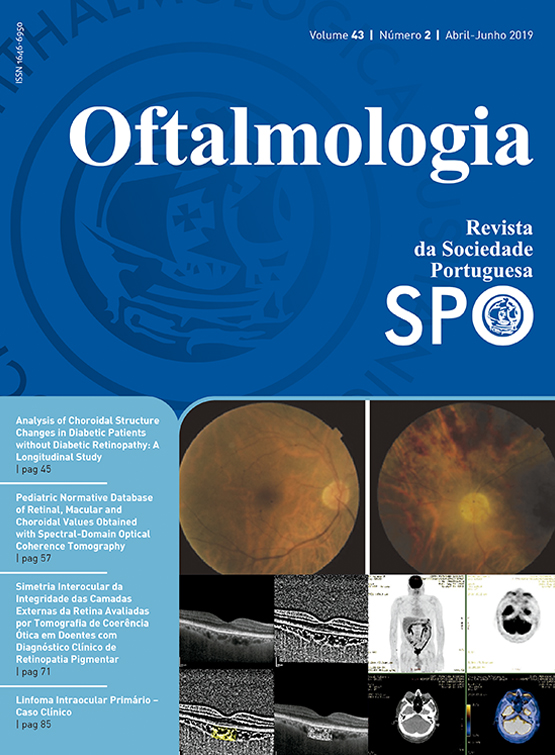Analysis of choroidal structure changes in diabetic patients without diabetic retinopathy
a longitudinal study
DOI:
https://doi.org/10.48560/rspo.15227Resumo
ABSTRACT
Purpose:
To identify changes in choroidal structure in diabetic patients without diabetic retinopathy (DR) that led to choroidal thickening after one year of follow-up, by differentiating alterations in the stromal and vascular areas of the choroid.
Methods:
Prospective observational cohort study in which 125 diabetic patients without DR were included, from October 2014 to December 2015. Patients received a complete ophthalmologic evaluation including spectral domain optical coherence tomography scans using enhanced depth imaging mode in the first visit (V1) and in a second visit after 12 months (V2). A 1500µm subfoveal choroidal area (total choroidal area [TCA]) was segmented into luminal area (LA) and stromal area (SA) using an image binarization technique. To assess the vascular status of the choroid, the choroidal vascularity index (CVI) was calculated as the proportion of LA to TCA. Generalized linear mixed-effects regression models were used.
Results:
Of the 125 patients, 103 completed the study, nine of which developed DR (8.7%). SA was significantly higher at V2 than at V1 (p=0.010), while CVI was significantly lower (p=0.028). TCA and SA were negatively associated with axial length (p=0.010 and p=0.011, respectively) and positively with CT (p<0.001). CVI was positively associated with axial length (p=0.001) and spherical equivalent (p<0.001). The presence of DR increased the CVI by 1.60% (p=0.042).
Conclusion:
After 12 months of follow-up, diabetic patients without DR at baseline appear to have a thicker choroid at the expense of decreased vascularity and stromal thickening. These structural changes may be due to ischemic processes in choroidal vasculature, with subsequent hyperpermeability and increased extracellular matrix deposition, and may represent the primary event in diabetes before the onset of DR.
Downloads
Downloads
Publicado
Como Citar
Edição
Secção
Licença
Não se esqueça de fazer o download do ficheiro da Declaração de Responsabilidade Autoral e Autorização para Publicação e de Conflito de Interesses
O artigo apenas poderá ser submetido com esse dois documentos.
Para obter o ficheiro da Declaração de Responsabilidade Autoral, clique aqui
Para obter o ficheiro de Conflito de Interesses, clique aqui





